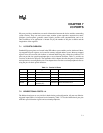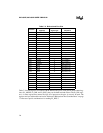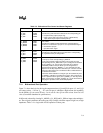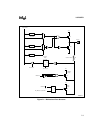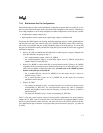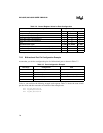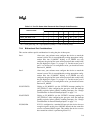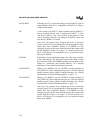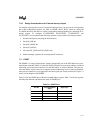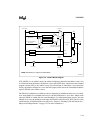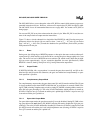
7-7
I/O PORTS
7.2.2 Bidirectional Port Pin Configurations
Each bidirectional port pin can be individually configured to operate either as an I/O pin or as a
pin for a special-function signal. In the special-function configuration, the signal is controlled by
an on-chip peripheral or an off-chip component. In either configuration, two modes are possible:
• complementary output (output only)
• high-impedance input or open-drain output (input, output, or bidirectional)
To prevent the CMOS inputs from floating, the bidirectional port pins are weakly pulled high dur-
ing and after reset, until your software writes to Px_MODE. The default values of the control reg-
isters after reset configure the pins as high-impedance inputs with weak pull-ups. To ensure that
the ports are initialized correctly and that the weak pull-ups are turned off, follow this suggested
initialization sequence:
1. Write to Px_DIR to establish the individual pins as either inputs or outputs. (Outputs will
drive the data that you specify in step 3.)
— For a complementary output, clear its Px_DIR bit.
— For a high-impedance input or an open-drain output, set its Px_DIR bit. (Open-drain
outputs require external pull-ups.)
2. Write to Px_MODE to select either I/O or special-function mode. Writing to Px_MODE
(regardless of the value written) turns off the weak pull-ups. Even if the entire port is to be
used as I/O (its default configuration after reset), you must write to Px_MODE to ensure
that the weak pull-ups are turned off.
— For a standard I/O pin, clear its Px_MODE bit. In this mode, the pin is driven as
defined in steps 1 and 3.
— For a special-function signal, set its Px_MODE bit. In this mode, the associated
peripheral controls the pin.
3. Write to Px_REG.
— For output pins defined in step 1, write the data that is to be driven by the pins to the
corresponding Px_REG bits. For special-function outputs, the value is immaterial
because the peripheral controls the pin. However, you must still write to Px_REG to
initialize the pin.
— For input pins defined in step 1, set the corresponding Px_REG bits.
Table 7-6 lists the control register values for each possible configuration. For special-function
outputs, the Px_REG value is irrelevant (don’t care) because the associated peripheral controls
the pin in special-function mode. However, you must still write to Px_REG to initialize the pin.
For a bidirectional pin to function as an input (either special function or port pin), you must set
Px_REG.





